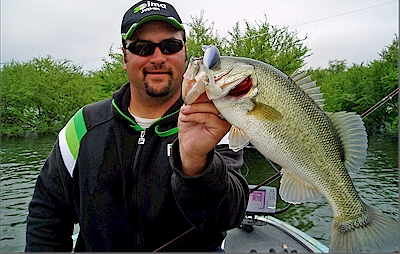Model: Roumba
Type: Floating, Topwater crankbait, Extreme wobbling/waking action
Body Length: 3" (75mm) excluding lip
Weight: 1/2 oz (16g)
Factory Hooks: Two #4 Owner ST-36 Black Nickel
Depth: Topwater (rod tip up) to 12-18 inches (rod tip down)
The Rumba is a high tempo, fast-stepping and seductive dance, and that describes the overcharged action of the ima Roumba too.
It cuts a rug across the top with a high energy, non-stop display of surface sidestepping intended to excite and arouse bass to dance with it.
Hold your rod tip high for best topwater action at any retrieve speed from super slow to blazingly fast - and any speed in between.
Hold the rod tip down to get the Roumba to dip under the surface, and crank the Roumba in a little faster to get it under about 1/2 foot or a foot deep.
No matter how you use it, the Roumba is a lure you should have tied on whenever bass are belting topwaters - or even when they aren't. Sometimes the "need for speed" is necessary to trigger strikes - but you'd never know that need for speed is there with regular lures because you ordinarily don't work those fast enough . The Roumba is one of the few topwaters that can move fast enough to get bit when they need speed to trigger strikes.
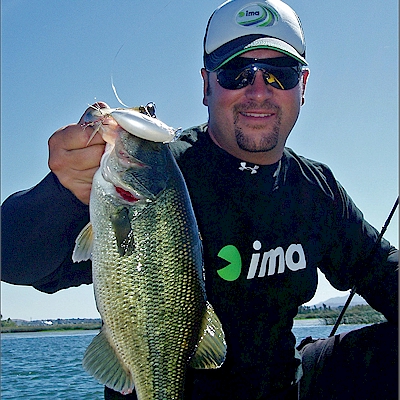
ima Roumba lure designer Fred Roumbanis
The Roumba has a unique, pudgy look. Once you get over its odd shape and throw it, you'll find it is very versatile. It may be used at any retrieve speed ranging from as slow as possible, barely crawling it across the surface - to as blazingly fast as possible. It excels at any speed. However, where the Roumba breaks away from the pack and leaves the other topwaters behind is that you can work it faster most any other topwater out there. There are times that speed is the trigger, and it is tough to figure out when. There are times that even lethargic fish that won't go for anything else, they'll go for an incredibly fast speed Roumba with raw instinctive reaction strikes.
There's really no need to give the Roumba any additional rod tip action. All the wild and seductive gyrations are built right into this topwater - thanks to ima lure designer and bass pro Fred Roumbanis (shown above).
Due to the crankbait like bill, the Roumba has more side-to-side action on its own, just reeling the Roumba steadily, than most other topwater lures. Unlike crankbaits, the bill is not designed to make the Roumba dive. The bill really only imparts side-to-side action to the bait. It causes the Roumba to move rapidly side-to-side, so there is no need to give it action with the rod tip. All the fantastic action is already built right into the Roumba for you.
Keep in mind, in terms of timing, topwaters can work all day but are typically at their best very early and late in the day when the light in the sky is changing - and the Roumba works well waked slowly at night too.
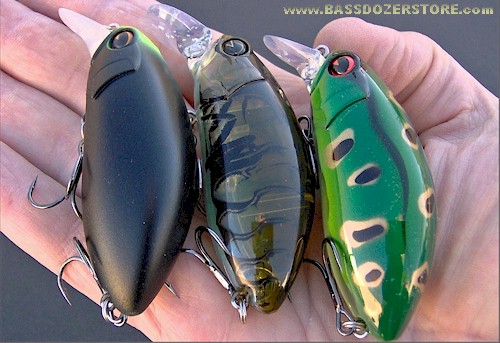
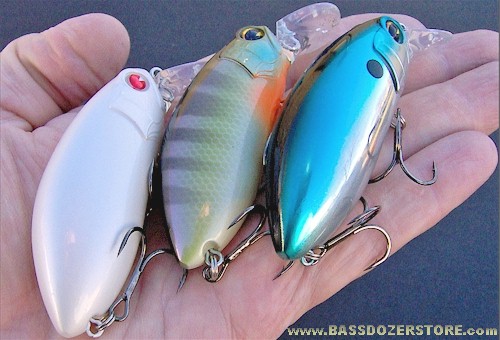
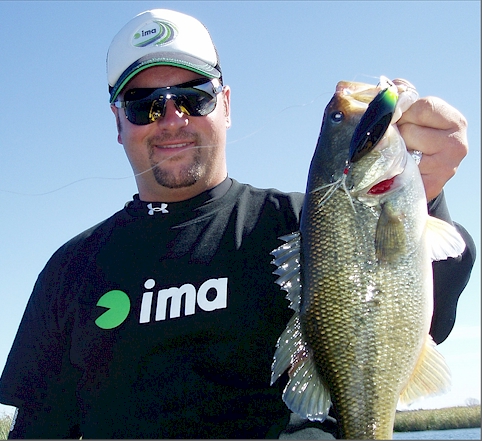
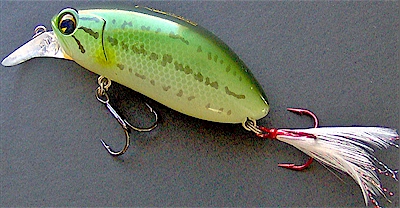
Replacing the tail with a feather treble (not included) improves the lure's action.
Roumba Fishing Tips from ima Pros Fred Roumbanis and Bill Lowen"The Roumba was designed to be a wakebait or topwater bait, something to be fished on top in water willows, lily pads, hydrilla, and milfoil that’s got open lanes and clearings through it,” says ima pro-staffer and Bassmaster Elite pro, Bill Lowen. "Especially if you are around water willows, reeds, brush or tall emergent grass, anything that sticks straight up, even hydrilla, that wild wake and built-in action of the Roumba will deflect grass and snags away from it, rendering the Roumba surprisingly weedless," adds fellow Bassmaster Elite pro and ima pro-staffer Fred Roumbanis adds, Roumbanis often replaces the back treble with a Gamakatsu feather treble hook on the tail, either a #4 or #2. "In open water, I’d rather upgrade to the #2. It’s a larger hook and you get an even better hook-up ratio. If you have any kind of grass however, you want to make sure to keep the feather treble the same size as the original #4 hook since the wobble of the Roumba is designed to actually deflect that grass away from that #4 size hook. The #4 gives the bait the ability to displace that grass away from the hooks," explains Roumbanis. Walking the Dog"When the shad are spawning early in the morning around floating docks, riprap, bridge pilings, anywhere there is clinging algae that the shad like to spawn over, the feather-tailed Roumba is an excellent choice in any of the shad colors. The Roumba is the perfect size and shape to mimic adult spawning shad!" exclaims Fred. For example, he'll take an Albino Roumba or a Bone Rattlin' Roumba and add a white feather on back. With the chartreuse and semi-transparent Sour Candy color, he’ll go with a little chartreuse and white feather on back. As mentioned earlier, many times there is no need to give the Roumba any rod action. All the surface-waking movement is built right. That's why this next tip may surprise some people because when shad are present, Roumbanis actually walks-the-dog with the feather-tailed Roumba like you would walk a Spook or Sammy. He’ll walk the Roumba back and forth using rod tip action. This works especially well with the Bone and shad-colored Rattlin' Roumbas. They have a one-knocker tungsten weight inside the plastic body shell. "You get a Chicka! Chicka! Chicka! sound as it sashays back and forth and that sound is really loud and really amplified in the morning stillness if you huck one right up against the bank where shad are active and walk it like a Spook," says Roumbanis. "The same technique applies to the Albino and other shad-colored Roumbas without the rattle." When you walk a Spook or Sammy, you usually keep it coming the whole time, and you can do that if you prefer, but Fred always like to pause the Roumba every 10 seconds or so. "That gets them good. As soon as you take off again, they attack it!” exclaims Fred. Other Fun ModificationsRoumba designer Fred Roumbanis adds several different kinds of soft baits to serve as action tails on the back of a Roumba. For example, he adds finesse worms or the tail ends of soft swimbaits. He attaches a wire corkscrew clip to the split ring above the tail treble hook, and then screws the soft bait tail onto the corkscrew so that the soft tail is independent of the treble hook. This adds greatly to the overall surface action, and embiggens the appearance of the lure, making it seem to be a bigger lure, due to the additional tail.
Bassmaster Elite pro Bill Lowen often adds a Willow or Colorado spinnerbait blade or two to the tail, using swivels (at times with a short wire extension arm) so the blades can rotate. Other times, he uses no swivel so the blade kind of flaps its tail instead of spinning. These mods are fun to try - but keep in mind that the Roumba is positively ready and waiting to catch fish for you the way it comes right out of the box! |
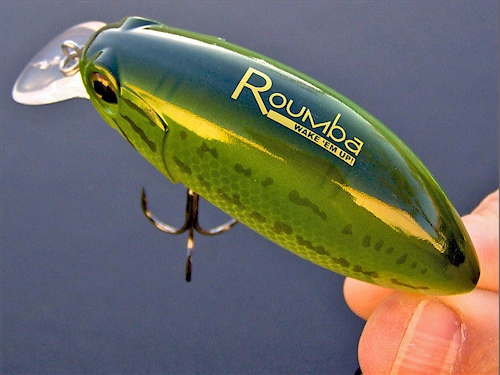
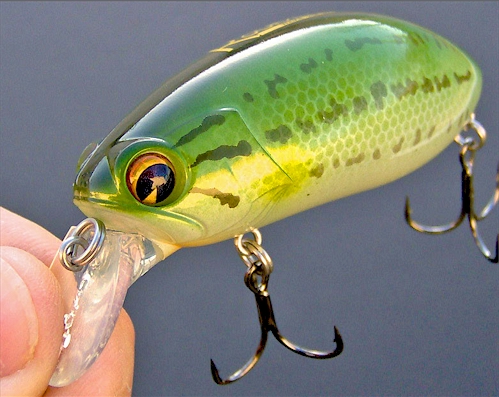
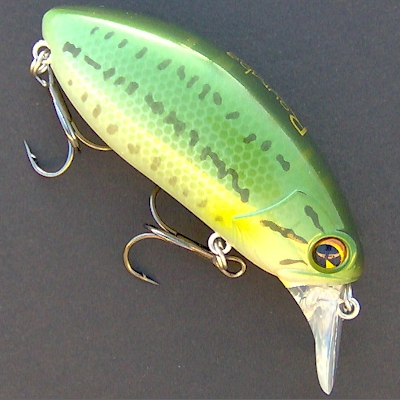
Ima Roumba ~ Topwater Crankbait ~ # 119 Baby Bass
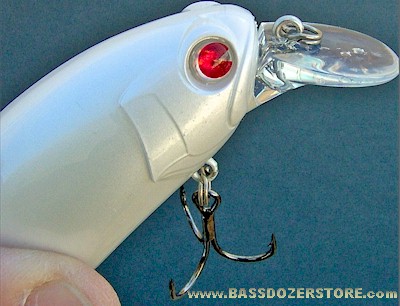
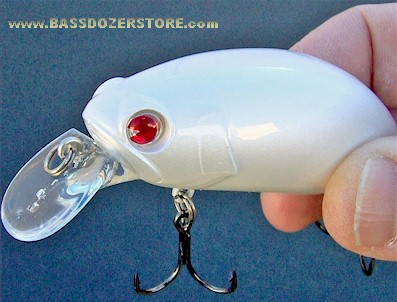
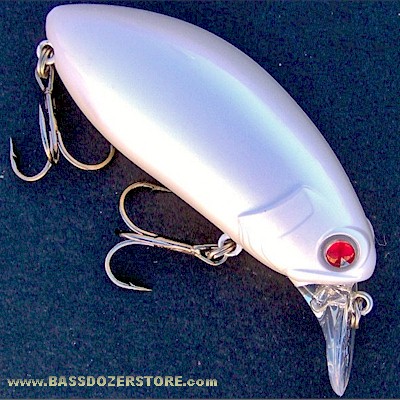
Ima Roumba ~ Topwater Crankbait ~ Albino
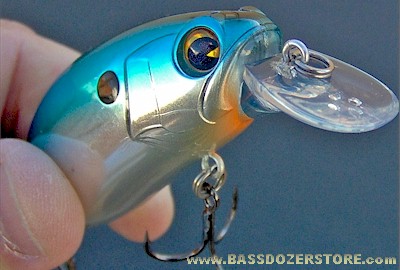
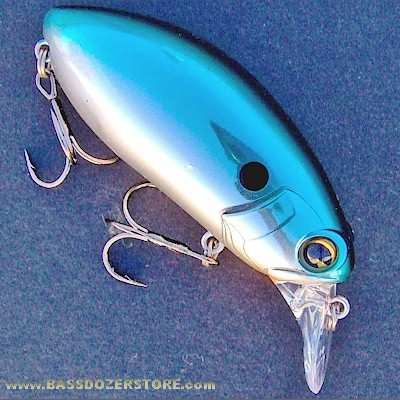
Ima Roumba ~ Topwater Crankbait ~ Gizzard Shad
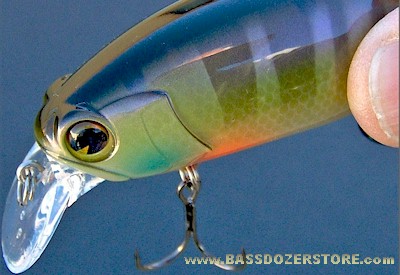
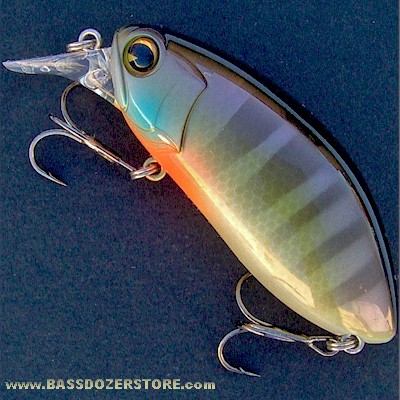
Ima Roumba ~ Topwater Crankbait ~ #103 Matte Bluegill
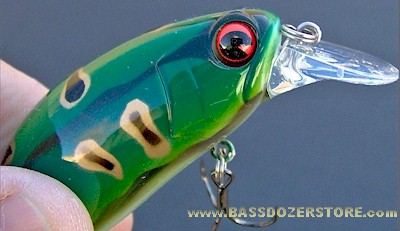
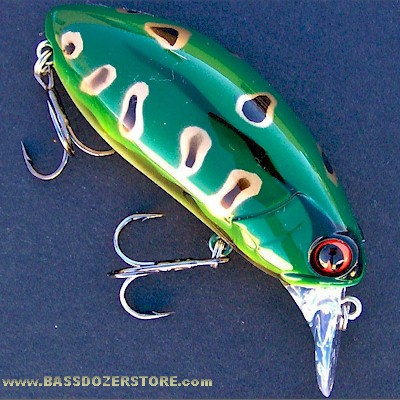
Ima Roumba ~ Topwater Crankbait ~ Bull Frog
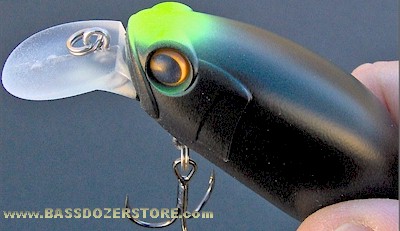
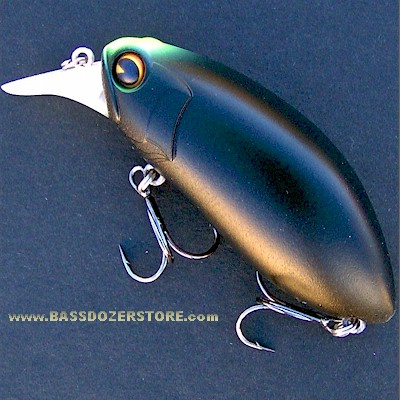
Ima Roumba ~ Topwater Crankbait ~ Stink Bug
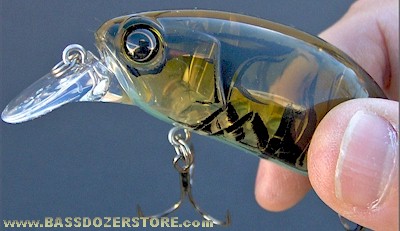
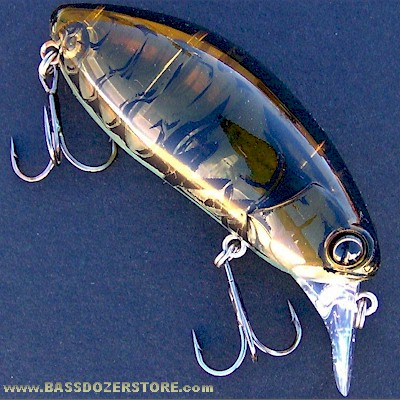
Ima Roumba ~ Topwater Crankbait ~ Real Crawfish
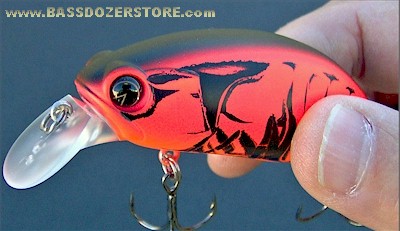
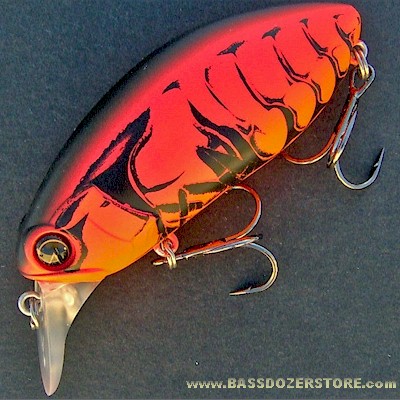
Ima Roumba ~ Topwater Crankbait ~ Hot Craw
ima Rattlin' Roumba ~ Topwater Crankbait
Model: Rattlin' Roumba
Type: Floating, Topwater Crankbait, Extreme wobbling/waking action
Weight: 5/8 oz (16g)
Body Length: 3" (75mm) excluding lip
Factory Hooks: Two #4 Owner ST-36 Black Nickel
Depth: Topwater (rod tip up) to 12-18 inches (rod tip down)
Some of the reasons why anglers love the original non-rattling Roumba are that it's so durable, has such a simple yet solid construction, and it has one of the widest, most vigorous wobbles of any topwater crankbait. The lip is not huge- but man does this bait wobble, even better than baits with much bigger lips. Since the Roumba's lip is small, it won't gunk up with grass as badly as other big-lipped baits. The body is pretty fat, and it has broad sides which shield the hooks from grass and debris. So it can come through thick grass surprisingly swell. It's streamlined and aerodynamic, weighs 5/8 oz, and casts incredibly far. Last but not least, it sports a great pair of hooks. Those are a few of the reasons why the original non-rattling Roumba has become something of a topwater sensation in a short time.
Now, the other, noisier shoe has fallen - the Rattlin' Roumba is here now!
The Rattlin' Roumba is everything the original Roumba is - plus rattles. It has the same 3-inch size, the same weight, body shape, hooks, lip and best of all, the same crazy, wide wobbling action.
Everything about the original Roumba and the Rattlin' Roumba are the same, except that the Rattlin' Roumba comes in six different colors that rattle. The rattle is not excessively loud, but creates a constant alluring, fish calling chatter.
So the Rattlin’ Roumba features six unique colors, including some brighter colors that bass just can't miss in dirty water, in conjunction with the rattling noise.
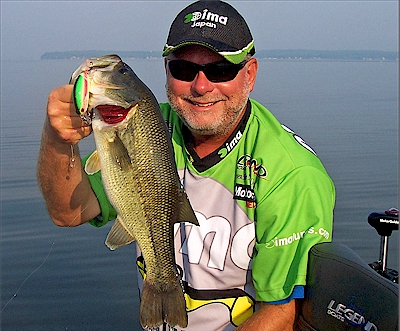
ima pro-staffer, Captain Karl Bunch shows a bold color named ‘Double Cheeseburger’ for added visibility - plus rattling noise - in stained or muddy water.
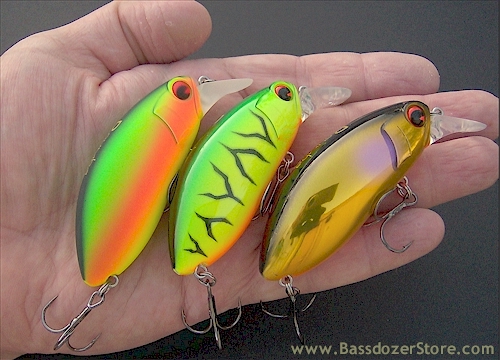
Rattlin' Roumba in bold fluorescent and black gold colors for low light, thick cover, dark-colored water or at night.
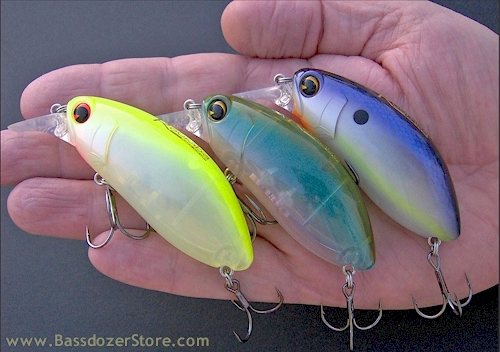
Rattlin' Roumba in lighter colors for clearer water, brighter skies, sparser cover.
The original non-rattling Roumba will continue to be just as good as it ever was, particularly with spooky, wary fish, in clear water, under bright skies, out in the open, away from cover and generally wherever and whenever topwater lures are working, give the original Roumba a try.
The Rattlin' Roumba is the one to try in dark and dirty water, around thick, grassy cover where bass can't see the surface so well, under low light conditions or at night. Also, whenever rain or strong wind suddenly muddies the water, try the Rattlin' Roumba.
But most of all, remember this: We tend to want to make neat, predictable rules for when different lure colors will work or for when to use rattling lures versus non-rattling lures. Truth is, there's no one who can make those kind of predictions with any accuracy for any given day. You just need to try different colors, and try the Rattlin' Roumba versus the original Roumba. Just experiment to see if fish favor one model or color over another at any particular time or place. Often, fish may hit several different ones. Some days, it may seem as if they prefer one versus another. Only trial-and-error and a little good luck can point you in the right direction.
Fishing Techniques
Best of all, there's nothing terribly skillful you need to do with either the original Roumba or Rattlin' Roumba. You don't need to learn how to make it splash or pop, nor how to make it walk. All you need to do is simply hold the rod tip at about ten or eleven o’clock and just a steady retrieve on a medium/heavy rod will give it a vociferous, wide wobbling movement that tears up the surface. That’s what gets their attention. It literally makes a turmoil rolling on the surface. Both the original Roumba and Rattlin' Roumba act the same, except the Rattlin' Roumba generates a resonant rattling noise in addition.
A second technique, equally simple is just to hold the rod tip down toward the water's surface, and that will make the Roumba or Rattlin' Roumba swim subsurface about one foot deep.
More Roumba Fishing Tips from ima Pros Michael Murphy and Captain Karl BunchMichael Murphy on the Original: Places where the original Roumba’s most advantageous are where you see a lot of shallow grass and overall, the Roumba’s really good when fish are shallow. There have been times I’ve caught fish with the Roumba by waking it in over 50 feet of water, but I think where the Roumba really shines is anytime when you’re anywhere shallow, and especially during the spawning season. That’s not to say the Roumba won’t work in the summer or fall – it does. But around the spawn when the fish are wanting to be in the shallows for a month or two, that’s when the Roumba really plays a role. The Roumba’s a good search tool when there are a lot of average size fish, say your 2-3 pounders. They may not always take the bait solidly but they will come up behind the Roumba and show themselves. So it’s a search tool, and it will tell you where a few of those 2-3 pound fish are, and they’ll go right back to a piece of cover, a log, or a stick-up. Some fish may have a bed that the Roumba pulled them away from… and they’ll go back into those spots. So you can pick up something else, a Texas-rigged worm or a Senko, and catch those relatively smaller fish that wouldn’t commit to the Roumba. That’s not to say you will not catch these 2-3 pounders on the Roumba. Yes, you will get a fair percentage of them – but not all of them will strike. What you’ll find different when it comes to bigger bass, is that you will pretty much stick the huge fish that come up on the Roumba. Usually, if you get around a big fish, it will commit. So the Roumba, if you throw it enough, it will definitely increase your chances to get those bigger fish, and in a tournament situation, the Roumba will get those good kicker fish you need these days. The Roumba has been proven to get that better grade of fish in shallow cover. Michael Murphy on the Rattlin': The Rattlin’ Roumba will really help in those painful tournament situations when you may have fish located shallow, maybe even sight-fishing on beds, but then the water dingies up overnight, whether it be from rain, wind or whatever causes a dirtier water situation overnight. So you still know the fish are there, you just can’t see them or you need to alert them a little bit more to the lure’s presence. The regular Roumba may not be enough in dingy water. That’s where the Rattlin’ Roumba can definitely help you. The wake is still there, with the rattling noise to help them locate it better in dingier water. Captain Karl Bunch on the Original: The Roumba is designed primarily to be a topwater wakebait. Simply hold the rod tip at about ten or eleven o’clock and just a steady retrieve on a medium/heavy rod will give it a nice, wide wobbling wake. There’s no rattle, just a wake – and that’s what gets their attention. The neat thing about the Roumba, if you are searching a shoreline, trying to find fish, you can effectively and easily cover a shoreline by first making three casts with the rod tip up to use the Roumba as a surface-roiling wakebait. Then make the next three casts with the rod tip down, so it runs about a foot deep with a real wide wobble. Depending on the fishing line used and retrieve speed, with the rod tip held down, the Roumba gets anywhere from 12-18 inches deep, typically about a foot. The effectiveness of this is that there are times when bass just don’t want to come up and hit a topwater. There are times they’re down tight on the wood, in the shallow wood, and using the Roumba as a shallow crankbait, it will come through wood cover very well. It will also come through light or scattered vegetation very well. The beauty is you don’t have to constantly switch between one rod for topwater and another rod for shallow-cranking. You can just use one rod, and the Roumba saves you a lot of time, saves a lot of energy and let’s you effectively and quickly cover a shoreline using it as a search bait. When I am guiding clients, I’ve had many days when the weather conditions may have changed overnight, when we must hunt to find the fish, and I’ll just instruct my clients to to do the same thing – make three casts using the Roumba as a topwater wakebait and three casts with the rod tip down, using it as a shallow running crankbait. Used this way, the Roumba has found the fish for me and my clients quickly and effectively many, many times, resulting in successful, productive trips. Captain Karl Bunch on the Rattlin': The Rattlin’ Roumba expands on the Roumba’s effectiveness. A guy who fishes water that’s really stained or muddy and feels he needs the rattling noise to go along with the wake, the Rattlin’ Roumba will allow him to do that, and it comes in several brighter colors to give dirty water anglers even more confidence. So the Rattlin’ Roumba features brighter colors for dirty water in conjunction with the rattling noise. So you’ll have two options. The Rattlin’ Roumba will be good in dirty water, but that same rattling noise may be too much for clear water where you may do better with the original non-rattling model. |
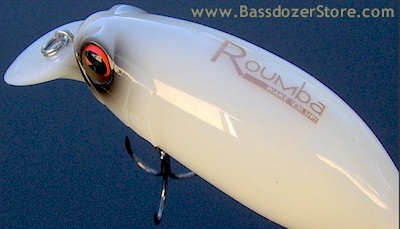
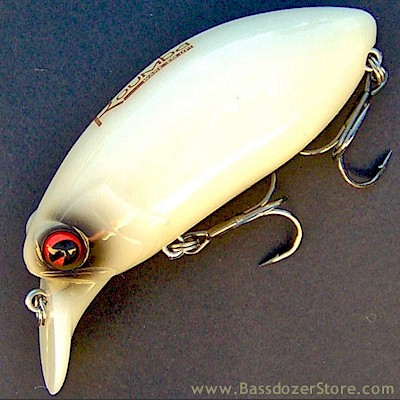
ima Rattlin' Roumba ~ Topwater Crankbait ~ Bone
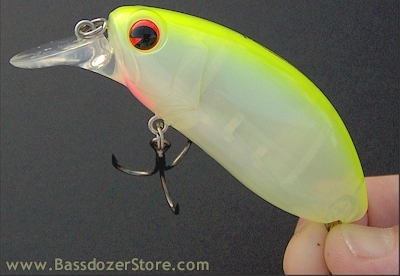
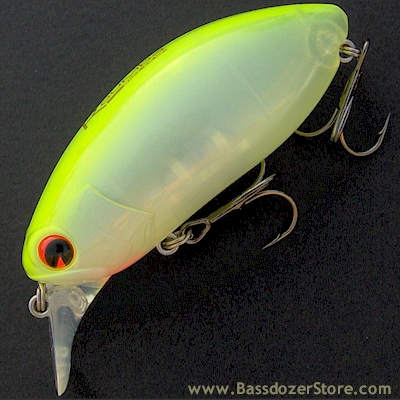
ima Rattlin' Roumba ~ Topwater Crankbait ~ #148 Sour Candy
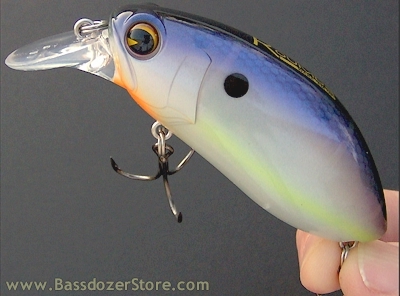
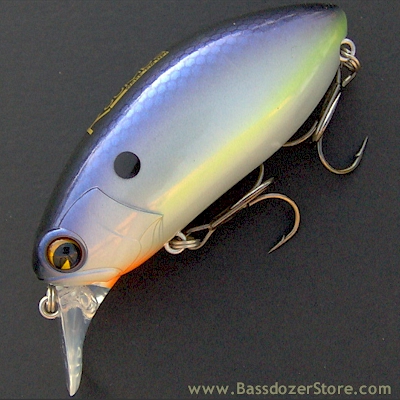
ima Rattlin' Roumba ~ Topwater Crankbait ~ #147 Blue Shad
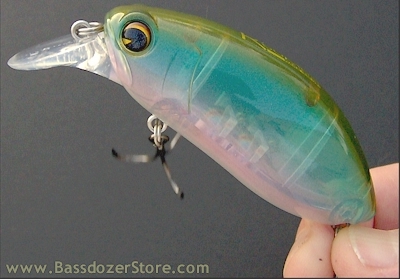
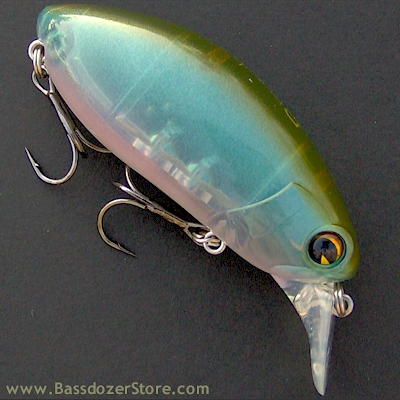
ima Rattlin' Roumba ~ Topwater Crankbait ~ Ghost Minnow
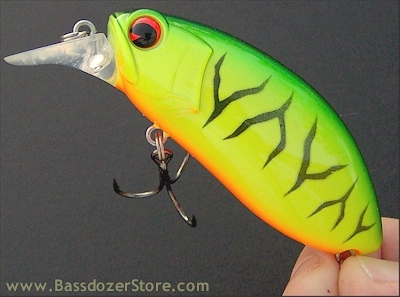
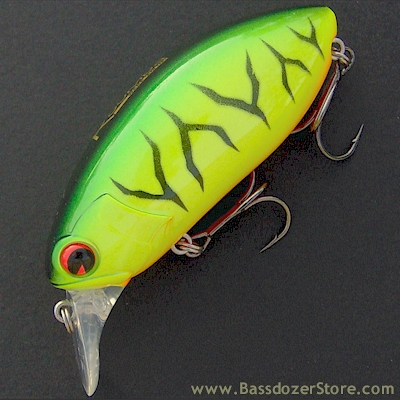
ima Rattlin' Roumba ~ Topwater Crankbait ~ Fire Tiger
Note that the Fire Tiger color has a bright orange belly.
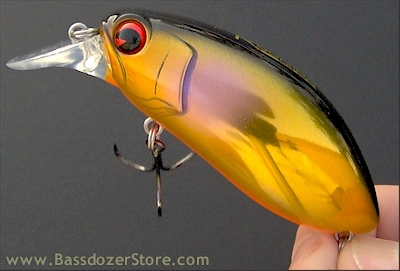
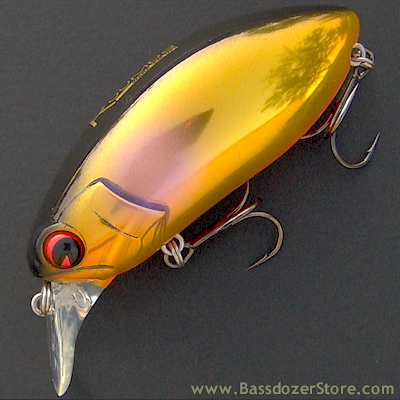
ima Rattlin' Roumba ~ Topwater Crankbait ~ Black Gold
Note: The Black Gold color has a bright orange belly.
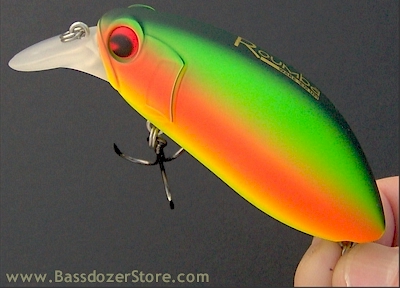
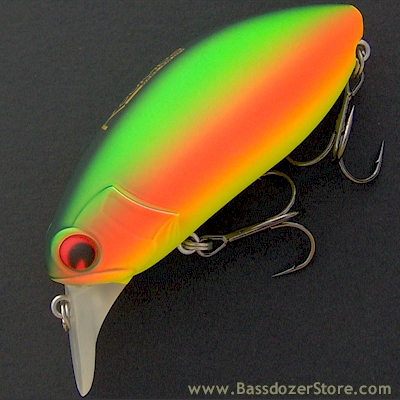
ima Rattlin' Roumba ~ Topwater Crankbait ~ Double Cheeseburger
|

